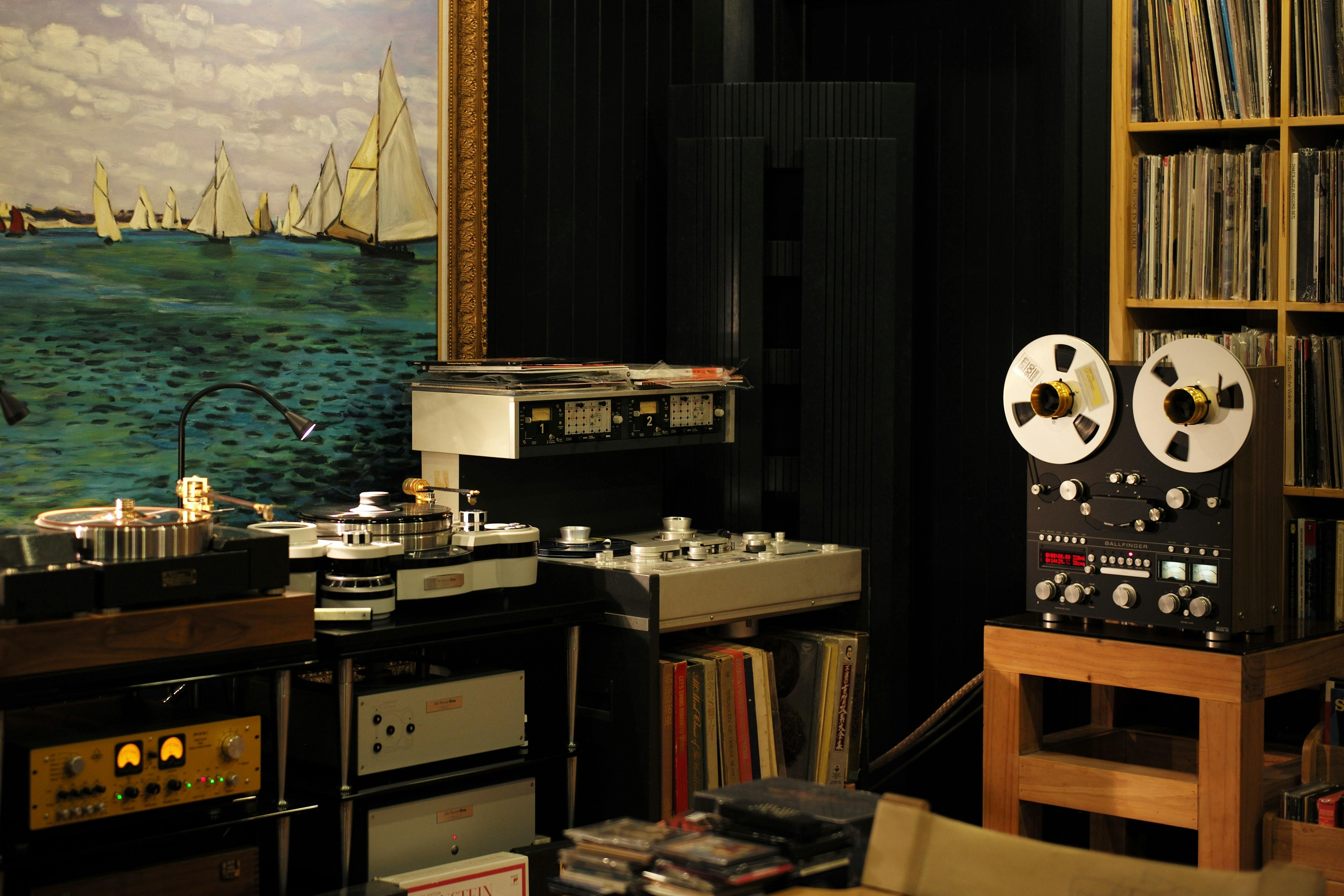In the intricate dance of vinyl playback, no component is more intimately connected to your records than the stylus – the tiny, often diamond, tip at the end of your turntable’s cartridge. Think of it as the tires on a high-performance sports car: you can have the most powerful engine and sophisticated suspension, but if the rubber doesn't meet the road effectively, you’re losing performance, detail, and potentially causing damage. Choosing the right stylus isn't just an upgrade; it's fundamental to achieving the sound quality your vinyl collection deserves.
Many newcomers (and even some seasoned listeners) overlook the profound impact this minuscule component has. But at XJ-HOME, we believe that understanding and optimizing every part of the audio chain, especially one as crucial as the stylus, is key to unlocking the true emotional power of music. So, let's demystify the process and guide you towards making an informed choice that will elevate your listening experience.
First, Some Terminology: Needle, Stylus, Cartridge?
While "needle" is a common colloquial term, the more accurate term for the diamond tip itself is the stylus. The stylus is attached to a cantilever (a tiny rod), which in turn is connected to the generating system (magnets and coils) housed within the cartridge body. When we talk about "choosing a needle," we're usually referring to selecting a replacement stylus for an existing cartridge, or choosing a new cartridge that comes with a specific stylus.
Key Considerations for Choosing Your Stylus:
1. Cartridge Compatibility: The First Hurdle
This is paramount. You can't just fit any stylus into any cartridge.
-
Direct Stylus Replacement: If you like your current cartridge but the stylus is worn or you want to upgrade the stylus profile (more on this later), you need to find a stylus specifically designed for that cartridge model. Many Moving Magnet (MM) cartridges offer user-replaceable styli. For example, an Audio-Technica AT-VM95E cartridge can accept any stylus from the VM95 series (conical, elliptical, nude elliptical, MicroLine, Shibata).
-
Moving Magnet (MM) vs. Moving Coil (MC):
-
MM Cartridges: Generally have user-replaceable styli. This makes them more economical in the long run as you only replace the stylus, not the entire cartridge body.
-
MC Cartridges: Most MC cartridges do not have user-replaceable styli. When the stylus wears out, the entire cartridge usually needs to be sent for a professional "retip" (where a specialist replaces the stylus and often the cantilever) or traded in for a new/refurbished one. This guide primarily focuses on choosing styli for MM cartridges or selecting new MM cartridges based on their stylus.
-
-
Mounting Type: P-Mount (T4P) vs. Standard ½-inch Mount:
-
P-Mount (T4P): A plug-and-play system popular on many Japanese turntables from the 1980s. Styli and cartridges are standardized for tracking force and alignment. Options are more limited but setup is foolproof.
-
Standard ½-inch Mount: The most common type, offering a vast array of cartridge and stylus choices. Requires manual alignment and setup.
-
2. The Stylus Shape (Profile): Where the Magic (and Cost) Happens
The shape of the diamond stylus tip is the single most important factor determining its performance – how much detail it retrieves, how well it tracks, and even how long it (and your records) will last.
-
Conical (Spherical):
-
Shape: A simple, ballpoint-like spherical tip.
-
Pros: Most affordable, robust, generally easy on poorly pressed or worn records, and less fussy about precise alignment.
-
Cons: Makes the smallest contact area with the groove walls, meaning it can't retrieve the finest high-frequency details. Can cause more record wear over time compared to advanced shapes at the same tracking force due to concentrating pressure on a smaller area. Often found on budget turntables.
-
Best For: Entry-level setups, playing older/worn records, budget-conscious listeners.
-
-
Elliptical (Bi-radial):
-
Shape: Two radii – a wider side-to-side radius and a narrower front-to-back radius, allowing it to sit deeper and more accurately in the groove.
-
Pros: A significant step up from conical. Offers improved high-frequency response, better detail retrieval, and lower distortion due to better groove contact.
-
Cons: More expensive than conical. More sensitive to proper alignment (VTA/SRA, azimuth).
-
Best For: Most mid-range hi-fi setups; a great balance of performance and price.
-
-
Advanced Shapes (Line Contact, Shibata, MicroLine/MicroRidge, Hyperelliptical, Fine Line):
-
Shape: These are complex, computer-designed shapes that closely mimic the shape of the cutting stylus used to make the record master. They have a very narrow side-radius for excellent high-frequency tracing and a long, vertical contact area.
-
Pros:
-
Exceptional Detail Retrieval: Unlocks the most information from the groove, revealing subtle nuances and extended high frequencies.
-
Superb Tracking: Can navigate complex passages with less distortion.
-
Reduced Record Wear: Despite their sharpness, their elongated vertical contact area distributes the tracking force over a larger groove wall surface, potentially leading to less record wear than simpler shapes when properly aligned.
-
Longer Stylus Life: Often made with higher quality diamonds and designed for longevity.
-
-
Cons: Most expensive. Extremely sensitive to precise alignment – Vertical Tracking Angle (VTA), Stylus Rake Angle (SRA), and azimuth must be spot-on for optimal performance. Will ruthlessly expose flaws in pressings or poorly maintained records.
-
Best For: High-end systems, critical listening, archivists, and those seeking the ultimate in vinyl playback fidelity. A deeper understanding of these advanced profiles can be found on educational sites; a search for "stylus shape comparison audiophile" will yield many detailed articles and diagrams.
-
3. Cantilever Material & Construction: The Unsung Hero
The cantilever transmits the stylus's vibrations to the cartridge's generator. Its material and construction affect resonance, stiffness, and mass.
-
Common Materials:
-
Aluminum: Most common, offers a good balance of stiffness and low mass for its cost.
-
Boron, Ruby, Sapphire, Beryllium (less common now), Diamond: Used in higher-end styli/cartridges. These materials are extremely stiff and lightweight, allowing for more accurate transmission of the stylus's movements with fewer unwanted resonances.
-
-
Nude vs. Bonded Stylus:
-
Bonded: A diamond tip is glued (bonded) to a metal shank, which is then inserted into the cantilever. Less expensive to manufacture.
-
Nude: A whole diamond is shaped and mounted directly into the cantilever. This reduces tip mass, allowing for better tracking of high frequencies and a more agile response. Generally preferred for higher fidelity.
-
4. Matching Your Turntable and Tonearm
There's little point in mounting a $500 exotic stylus on a $100 entry-level turntable with a basic tonearm. The system should be balanced. A highly resolving stylus will expose the limitations of a lesser tonearm (e.g., bearing friction, resonances) or turntable (e.g., motor noise, platter instability). Conversely, a high-quality turntable and tonearm will allow a superior stylus to truly shine.
5. Your Budget
Stylus prices range dramatically:
-
Budget (Under $50): Mostly conical, some basic bonded ellipticals.
-
Mid-Range ($50 - $200): Good quality ellipticals, some nude ellipticals.
-
Upper Mid-Range ($200 - $500): Entry-level line contact shapes, high-quality nude ellipticals.
-
High-End ($500+): Advanced line contact shapes (Shibata, MicroLine), exotic cantilever materials.
6. When to Replace Your Stylus
Styli don't last forever. Using a worn stylus will result in distorted sound and, crucially, can permanently damage your records.
-
Audible Cues: Listen for increased sibilance (exaggerated "s" sounds), general distortion (especially on inner grooves or loud passages), a loss of high-frequency detail, or a "fuzzy" sound.
-
Recommended Hours: This is a rough guide and varies by stylus shape, tracking force, and record cleanliness:
-
Conical: ~300-500 hours
-
Elliptical: ~500-800 hours
-
Line Contact/Advanced Shapes: ~800-2000+ hours
-
-
Unknown History: If you buy a used turntable or cartridge, it's always safest to assume the stylus is due for replacement unless you know its history.
The XJ-HOME Philosophy: Precision and Musicality
At XJ-HOME (https://xenonjade.com), we believe the stylus is where the rubber truly meets the road in vinyl playback. Investing in the best stylus your system and budget can accommodate is one of the most impactful upgrades you can make. It’s about respecting the artistry captured in those grooves and allowing your system to convey the music with clarity, detail, and emotional impact. We advocate for careful alignment and a balanced approach, ensuring your chosen stylus can perform to its full potential.
The Final Cut: Choose Wisely
Choosing the right stylus is a journey of understanding your equipment, your listening preferences, and your budget. Don't be afraid to research, read reviews, and consult with reputable dealers. The effort invested will be richly rewarded every time you lower that perfectly matched diamond into the groove and the music springs to life. Happy listening!





Leave a comment
All comments are moderated before being published.
This site is protected by hCaptcha and the hCaptcha Privacy Policy and Terms of Service apply.